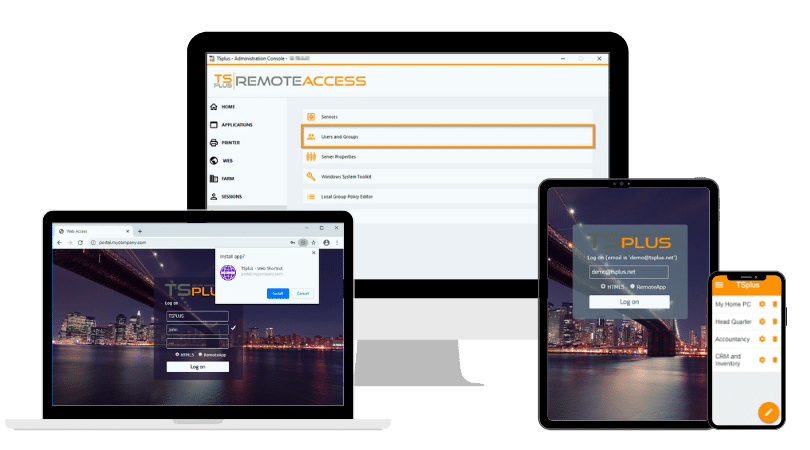What is RDP?
Remote Desktop Protocol (RDP) is a secure network communications protocol developed by Microsoft. It is a critical tool for IT administrators, allowing them to remotely manage servers and workstations efficiently.
However, encountering errors such as the RDP Error Code 0x4 can halt productivity and pose significant challenges. This article dives deep into the technical nuances of the error, offering advanced solutions for IT professionals seeking to restore connectivity.
What is RDP Error Code 0x4?
RDP Error Code 0x4 is a common issue which IT professionals may encounter when attempting to establish a remote desktop connection between client and server systems. This error indicates a failure in the connection process. This error can be attributed to a variety of factors.
Let’s explore the common causes for this code to appear.
What are Common Causes for Code 0x4 Errors?
Common causes that can create a code 0x4 error can be these ones:
- Network Connectivity Issues
- Firewall and Security Settings
- System and Service Configuration
- Software Updates and Compatibility
1. Network Connectivity Issues
The stability and quality of the network connection between the RDP client and server are fundamental to successful remote desktop sessions. Interruptions, high latency or packet loss in the network can prevent the RDP client from establishing a connection to the server. This will trigger error code 0x4.
2. Firewall or Security Settings Restrictions
Firewalls and security applications play a crucial role in protecting network traffic. Yet, in this case, they can also inadvertently block RDP connections, particularly if incorrectly configured or set to overly restrictive modes.
3. Incorrect System and Service Configuration
Correct configuration of both the client and server systems is essential for RDP connections. Whether in RDS or another client, misconfiguration can lead to unsuccessful attempts to connect. The client needs to be enabled and running properly on the server, user permissions correctly set, etc. Group policies or domain-level restrictions can also interfere. Any of these will likely manifest as Error Code 0x4.
4. Outdated or Incompatible Software
Software updates and compatibility versions of an RDP client or server software can also generate connection issues, including Error Code 0x4. Likewise, compatibility between client and server operating systems is another factor.
Now we know what can cause RDP 0x4 errors, time to move on to troubleshooting.
How to Troubleshoot and Resolve Code 0x4 Errors?
Here are the ways to resolve and troubleshoot code 0x4 errors:
- Fixing Network Issues
- Optimizing System and Service Configuration
- Pushing Software Updates and Compatibility
- Consider Advanced Solutions
1. Fixing Network Issues
Use diagnosis tools such as ping and traceroute to fix network problems by testing latency and packet travel. Indeed, such analysis can pinpoint where disruptions occur.
Additionally, network monitoring tools can help visualize traffic flow and detect bottlenecks.
What are the possible resolutions for RDP 0x4 network issues?
- Resolve physical connection issues
- Reset routers or switches if needed
- Ensure there is adequate bandwidth.
- Consider prioritizing RDP traffic through Quality of Service (QoS) policies on the network.
2. Adjusting Firewall and Security Settings
A firewall is the first line of defense which monitors incoming and outgoing traffic. According to Cisco, firewalls decide to allow or block specific traffic based on a defined set of security rules.
How to carry out firewall diagnostics?
- Examine the firewall settings on both the client and server sides.
- Ensure that RDP traffic is allowed on TCP port 3389 and consider temporarily disabling the firewall for diagnostic purposes.
- Check firewall logs for blocked traffic (such as above port 3389).
- Remember any intermediate network devices or additional security software which might filter or block such connections.
Wrapping up firewall troubleshooting steps:
That done, brush over items such as adjusting firewalls and antivirus software configuration to allow RDP communication. Overall, after temporarily disabling any components for testing, remember to reconfigure as necessary.
3. Optimising System and Service Configuration
Ensure the RDS is active on the server and properly configured, remembering that simply restarting the service may resolve transient issues.
What permissions to implement?
- Verify the user account has remote access rights.
- Review group policies for discrepancies to ensure no domain rules are affecting remote access.
Final resolution steps for system and services:
Such review of both the client and server RDP settings should release any related RDP access restrictions, thanks to corrected user permissions, server remote connection settings and domain policies.
4. Updating Software and Aligning for Compatibility
The following software update and alignment work will serve to iron out related RDP issues.
- Check all machines for up-to-date versions of Windows or other operating systems, RDP protocol.
- On older systems, adjust the RDP client's compatibility settings to better match the server environment.
5. Considering Advanced Solutions
Windows Registry tweaks
Modify the MaxOutstandingConnections key in the Windows Registry, on the server side, to increase the number of simultaneous connections. This will alleviate certain persistent issues.
QoS and network tuning
Adjust network Quality of Service to give priority to RDP packets, particularly in high-traffic or limited bandwidth scenarios.
With the problem diagnosed and fixed, let us proceed to the next stage: ensuring issues are avoided at the root for smoother network usage.
How to Prevent Future RDP Connection Issues?
Here are the ways to prevent future RDP connection issues:
- Robust Network Monitoring and Optimization
- System Updates and Configuration Management
- Enhancing User Education and Best Practices
Robust Network Monitoring and Optimization
Implement continuous network monitoring
Continuous monitoring of the network infrastructure is essential for early detection of RDP connection issues and reactiveness. By using network monitoring tools, you can track the relevant performance metrics mentioned above (latency, packet loss, throughput) in real time. Doing this will allow quick responses to network instability or congestion.
Example tools and techniques
Leverage tools such as TSplus Server Monitoring for server and website surveillance, Wireshark for packet analysis, Nagios for infrastructure monitoring, or SolarWinds for comprehensive network performance monitoring. These tools can help identify bottlenecks, unauthorized access attempts or failing network hardware.
Optimizing network performance
As seen, optimizing the network for RDP traffic can involve configuring QoS rules to prioritize RDP packets. Additionally, keep network hardware and firmware updated in order to improve performance and compatibility.
Best practice to optimize performance
- create and implement QoS policies;
- regularly review and updates of network infrastructure, protocols etc;
- match the highest known security standards.
System Updates and Configuration Management
Implement an update strategy to keep systems up to date
- Regular OS, RDP and software updates are crucial.
- Automate this process where possible, using tools like Windows Server Update Services (WSUS) for Microsoft environments.
- Do ensure updates are first tested in a staging environment to avoid deployment issues.
Updates often contain fixes for known issues that could impact RDP connections, including those that might lead to Error Code 0x4.
Plan regular configuration reviews
Schedule periodic reviews of system configurations, including verifying protocols are correctly enabled, firewall rules appropriate and user permissions accurately assigned. This will ensure that configurations remain optimized for security and functionality.
Configuration tools and network management
Use configuration management tools like TSplus Remote Support for screen control and maintenance, Microsoft Group Policy for Windows environments or Ansible for cross-platform environments to standardize and enforce configuration policies across the organization.
Enhancing User Education and Best Practices
Educate users on secure remote access practices
Educate end users on topics such as secure RDP practices, how to recognize security threats and reporting connectivity issues promptly. This may involve specific training around strong, unique passwords or the dangers of unsecured connections.
Promote best practice for RDP use and enforce secure policies
- Promote best practice among users, such as disconnecting from sessions to free bandwidth.
- Enforce the use of two-factor authentication (2FA) or multi-factor authentication (MFA) for RDP access.
- Set automatic session timeouts.
- Regularly audit RDP access.
As with any upkeep, there is always work to be done. These items will give your RDP based connections a new sheen. Still, for further prevention and better tuning yet, consider additional software such as the TSplus software suite.
Leveraging TSplus to Resolve the RDP Error Code 0x4
By replacing standard RDP with an enhanced, web-enabled remote access platform, TSplus reduces the risk of compatibility issues and improves session reliability, helping prevent common errors like RDP Error Code 0x4. TSplus offers comprehensive and cost-effective solutions designed to improve remote access.
Furthermore, with TSplus Advanced Security, Remote Support and Server Monitoring, IT teams gain powerful tools to protect RDP sessions, monitor usage in real time and proactively address performance or security issues. Our all-in-one platform empowers administrators to effectively resolve connection problems like 0x4 errors while enhancing overall user experience.
Conclusion
Resolving RDP Error Code 0x4 demands a methodical approach that includes identifying root causes, performing targeted diagnostics and applying tested solutions. By leveraging continuous network monitoring, ensuring systems are up to date and fostering a culture of security awareness among users, you can lay a solid foundation for stable and secure remote access.
TSplus Remote Access Free Trial
Ultimate Citrix/RDS alternative for desktop/app access.Secure, cost-effective,on-permise/cloud









)



)
)
)
)



